oil temperature PONTIAC GRAND AM 1998 Owners Manual
[x] Cancel search | Manufacturer: PONTIAC, Model Year: 1998, Model line: GRAND AM, Model: PONTIAC GRAND AM 1998Pages: 370, PDF Size: 16.11 MB
Page 81 of 370
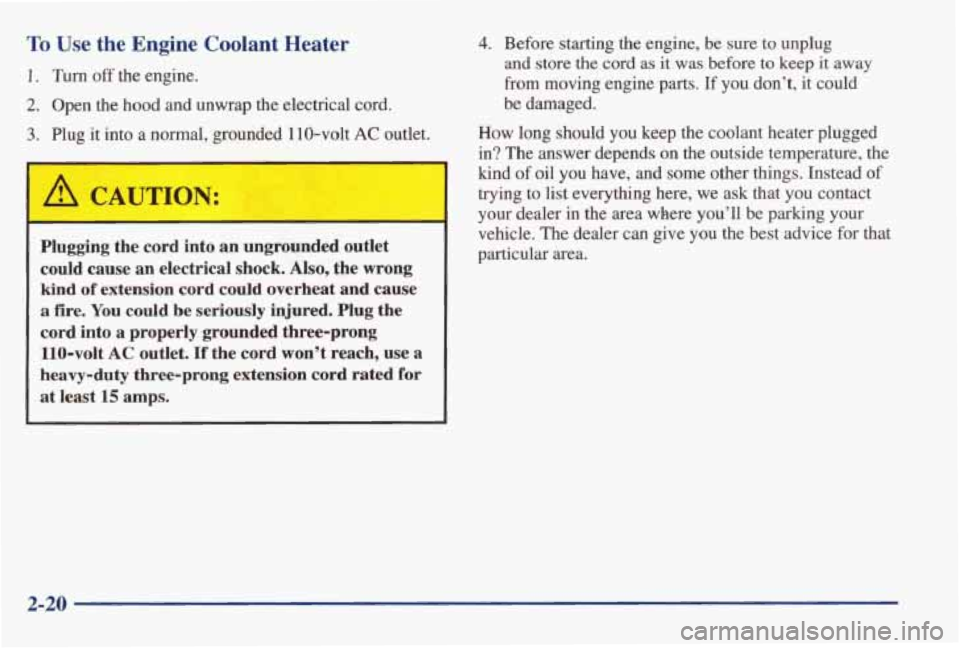
To Use the Engine Coolant Heater
1. Turn off the engine.
2. Open the hood and unwrap the electrical cord.
3. Plug it into a normal, grounded 110-volt AC outlet.
A CAUTION:
Plugging the cord into an ungrounded outlet
could cause an electrical shock. Also, the wrong
kind of extension cord could overheat and cause
a fire. You could be seriously injured. Plug the
cord into a properly grounded three-prong 110-volt
AC outlet. If the cord won’t reach, use a
heavy-duty three-prong extension cord rated for
at least 15 amps.
4. Before starting the engine, be sure to unplug
and store the cord as it was before to keep it away
from moving engine parts. If you don’t, it could
be damaged.
How long should you keep the coolant heater plugged
in? The answer depends on
the outside temperature, the
kind
of oil you have, and some other things. Instead of
, trying to list everything here, we ask that you contact
your dealer in the area where you’ll be parking
your
vehicle. The dealer can give you the best advice for that
particular area.
2-20
Page 250 of 370
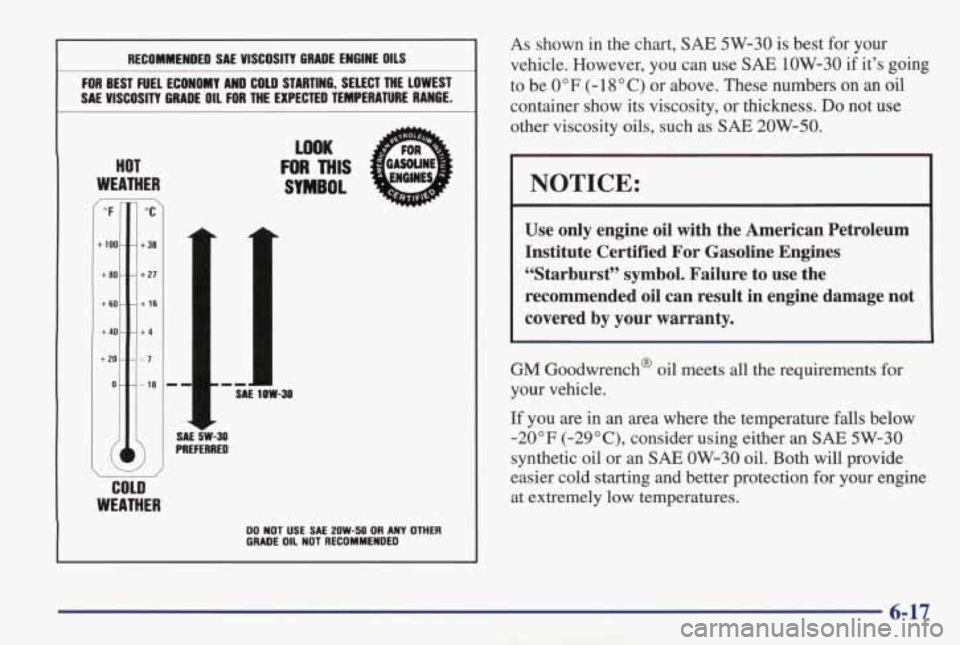
FOR BEST FUEL ECONOMY AND COLD Y’76, SELECT THE LOWEST
SAE
VISCOSITY GRADE OIL FOR THE EL. ----J TEMPERATURE RANGE.
HOT
WEATHER
’TC)
SAE sw-30 PREFERRED
COLD
WEATHER
LOOK
FOR THIS
SYMBOL 7
,I SAE I low-31
00 NOT USE SAE 2OW-50 OR ANY OTHER
GRADE OIL NOT RECOMMENDED
As shown in the chart, SAE 5W-30 is best for your
vehicle. However, you can use
SAE 1OW-30 if it’s going
to
be 0” F (- 18 O C) or above. These numbers on an oil
container show its viscosity, or thickness. Do not use
other viscosity oils, such as SAE 20W-50.
I NOTICE:
Use only engine oil with the American Petroleum
Institute Certified For Gasoline Engines
“Starburst” symbol. Failure to use the
recommended oil can result in engine damage not
covered by your warranty.
GM Goodwrench@ oil meets all the requirements for
your vehicle.
If you
are in an area where the temperature falls below
-20°F (-29”C), consider using either an
SAE 5W-30
synthetic oil or an
SAE OW-30 oil. Both will provide
easier cold starting and better protection for your engine
at extremely low temperatures.
6-17
Page 251 of 370
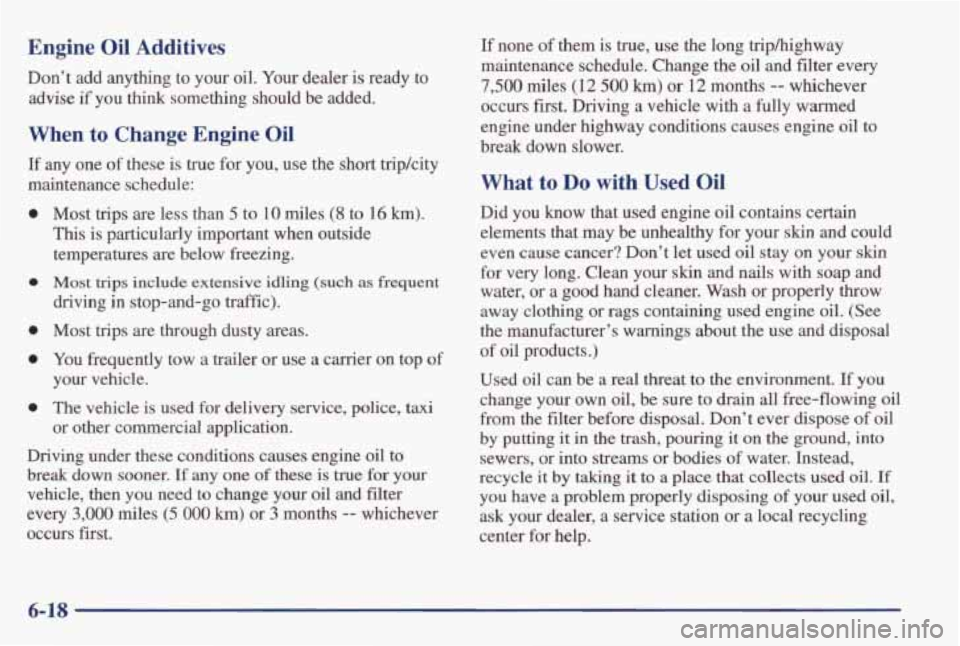
Engine Oil Additives
Don’t add anything to your oil. Your dealer is ready to
advise
if you think something should be added.
When to Change Engine Oil
If any one of these is true for you, use the short triplcity
maintenance schedule:
0
0
0
0
0
Most trips are less than 5 to 10 miles (8 to 16 km).
This is particularly important when outside
temperatures are below freezing.
Most trips include extensive idling (such as frequent
driving in stop-and-go traffic).
Most trips are through dusty areas.
You frequently tow a trailer or use a carrier
on top of
your vehicle.
The vehicle is used for delivery service, police,
taxi
or other commercial application.
Driving under these conditions causes engine oil to
break
down sooner. If any one of these is true for your
vehicle, then
you need to change your oil and filter
every
3,000 miles (5 000 km) or 3 months -- whichever
occurs first.
If none of them is true, use the long triphighway
maintenance schedule. Change the
oil and filter every
7,500 miles (12 500 km) or 12 months -- whichever
occurs first. Driving a vehicle with a fully warmed
engine under highway conditions causes engine oil to
break down slower.
What to Do with Used Oil
Did you know that used engine oil contains certain
elements that may be unhealthy for your skin and could
even cause cancer? Don’t let used oil stay on your
skin
for very long. Clean your skin and nails with soap and
water,
or a good hand cleaner. Wash or properly throw
away clothing or rags containing used engine oil. (See
the manufacturer’s warnings about the use and disposal
of oil products.)
Used oil
can be a real threat to the environment. If you
change your own oil, be sure to drain all free-flowing oil
from the filter before disposal. Don’t ever dispose
of oil
by putting
it in the trash, pouring it on the ground, into
sewers, or into streams or bodies of water. Instead,
recycle
it by taking it to a place that collects used oil. If
you have a problem properly disposing of your used oil,
ask your dealer, a service station or a local recycling
center for help.
6-18
Page 253 of 370

Automatic Transaxle Fluid
When to Check and Change
A good time to check your automatic transaxle fluid
level is when the engine oil is changed.
Change both the fluid and filter
every 50,000 miles
(83 000 km) if the vehicle is mainly driven under one
or more
of these conditions:
0 In heavy city traffic where the outside temperature
0 In hilly or mountainous terrain.
When doing frequent trailer towing.
regularly reaches
90°F (32°C) or
higher.
0 Uses such as found in taxi, police or delivery service.
If you do not use your vehicle under any
of these
conditions, the fluid and filter do not require changing.
See “Scheduled Maintenance Services” in the Index.
How to Check
Because this operation can be a little difficult, you may
choose
to have this done at your Pontiac dealership
Service Department.
If you do it yourself, be sure to follow all the
instructions here, or you could get a false reading on
the dipstick.
NOTICE:
Too much or too little fluid can damage your
transaxle.
Too much can mean that some of the
fluid could come out and
fall on hot engine parts
or exhaust system parts, starting
a fire. Be sure to
get an accurate reading if you check your
transaxle fluid.
6-20
Page 258 of 370
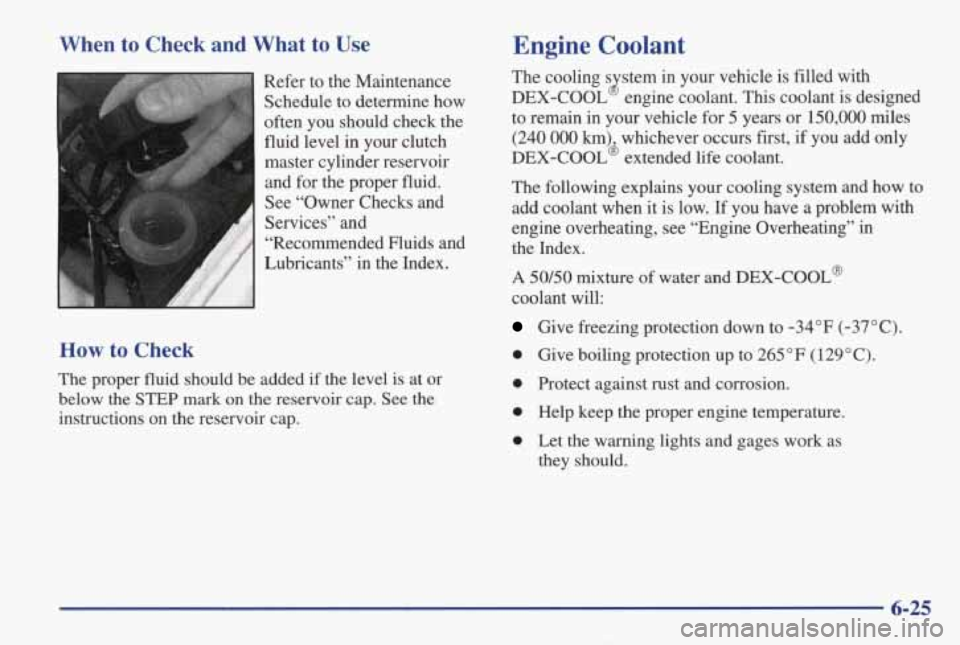
When to Check and What to Use
Refer to the Maintenance Schedule to determine how
often you should check the
fluid level in your clutch
master cylinder reservoir
and for the proper fluid.
See “Owner Checks and
Services” and
“Recommended Fluids and
Lubricants” in the Index.
How to Check
The proper fluid should be added if the level is at or
below the
STEP mark on the reservoir cap. See the
instructions on the reservoir cap.
Engine Coolant
The cooling s stem in your vehicle is filled with
DEX-COOL engine coolant. This coolant is designed
to remain in your vehicle for
5 years or 150,000 miles
(240 000 km) whichever occurs first, if you add only
DEX-COOL’ extended life coolant.
The following explains your cooling system and how to
add coolant when it is low. If you have
a problem with
engine overheating, see “Engine Overheating” in
the Index.
J
A 50/50 mixture of water and DEX-COOL@
coolant will:
Give freezing protection down to -34°F (-37°C).
0 Give boiling protection up to 265 OF (1 29 O C).
0 Protect against rust and corrosion.
0 Help keep the proper engine temperature.
0 Let the warning lights and gages work as
they should.
6-25
Page 306 of 370
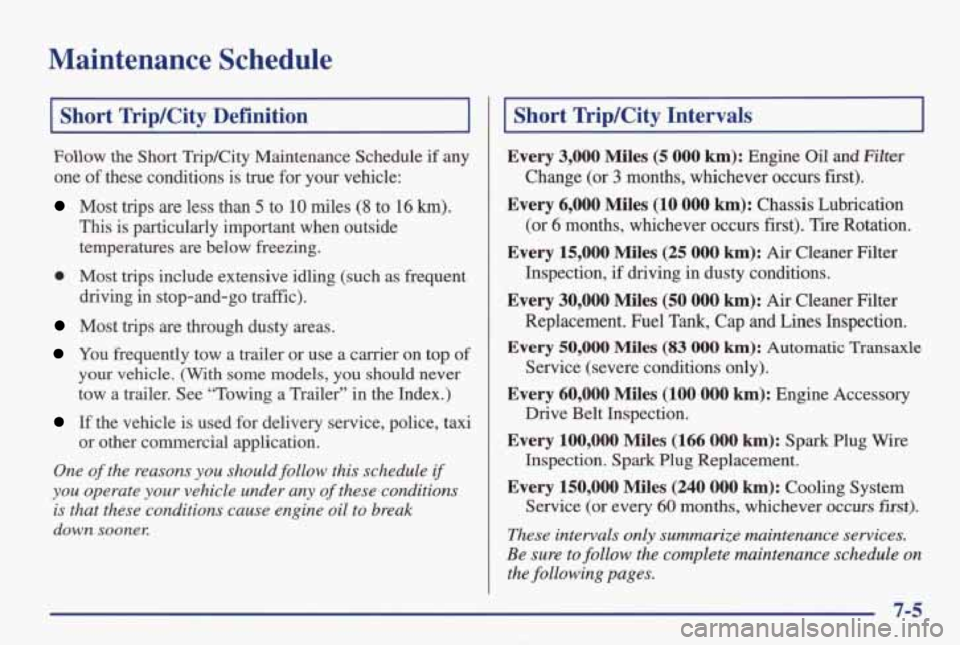
Maintenance Schedule
I Short TripKity Definition I
Follow the Short TripKity Maintenance Schedule if any
one
of these conditions is true for your vehicle:
Most trips are less than 5 to 10 miles (8 to 16 km).
This is particularly important when outside
temperatures are below freezing.
0 Most trips include extensive idling (such as frequent
driving in stop-and-go traffk).
Most trips are through dusty areas.
You frequently tow a trailer or use a carrier on top of
your vehicle. (With some models, you should never
tow a trailer.
See “Towing a Trailer” in the Index.)
If the vehicle is used for delivery service, police, taxi
One of the reasons you should follow this schedule if
you operate your vehicle under any of these conditions
is that these conditions cause engine
oil to break
down sooner.
or other commercial application.
Short TripKity Intervals
Every 3,000 Miles (5 000 km): Engine Oil and Filter
Change (or 3 months, whichever occurs first).
Every 6,000 Miles (10 000 km): Chassis Lubrication
(or
6 months, whichever occurs first). Tire Rotation.
Every 15,000 Miles (25 OOO km): Air Cleaner Filter
Inspection, if driving in dusty conditions.
Every 30,000 Miles (50 000 km): Air Cleaner Filter
Replacement. Fuel Tank, Cap and Lines Inspection.
Every 50,000 Miles (83 0oO km): Automatic Transaxle
Service (severe conditions only).
Every 60,000 Miles (100 000 km): Engine Accessory
Drive Belt Inspection.
Every 100,000 Miles (166 000 km): Spark Plug Wire
Inspection. Spark Plug Replacement.
Every 150,000 Miles (240 000 km): Cooling System
Service (or every
60 months, whichever occurs first).
These intervals only summarize maintenance services.
Be sure to follow the complete maintenance schedule
on
the following pages.
7-5
Page 314 of 370
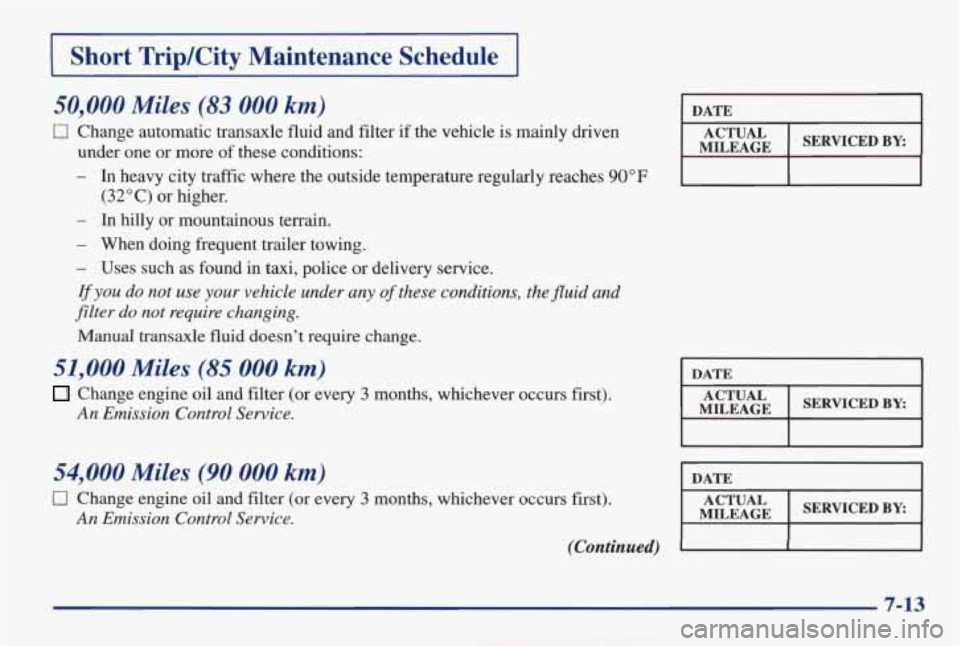
1 Short TripKity Maintenance Schedule I
50,000 Miles (83 000 km)
0 Change automatic transaxle fluid and filter if the vehicle is mainly driven
under one or more of these conditions:
- In heavy city traffic where the outside temperature regularly reach\
es 90°F
- In hilly or mountainous terrain.
- When doing frequent trailer towing.
- Uses such as found in taxi, police or delivery service.
If you do not use your vehicle under any of these conditions, the fluid and
filter
do not require changing.
Manual transaxle fluid doesn't require change.
(32°C) or higher.
51,000 Miles (85 000 km)
Change engine oil and filter (or every 3 months, whichever occurs first).
An Emission Control Service.
54,000 Miles (90 000 km)
0 Change engine oil and filter (or every 3 months, whichever occurs first).
An Emission Control Service.
(Continued)
DATE I
DATE I
DATE I
Page 320 of 370

I Short TripKity Maintenance Schedule I
0 Rotate tires. See “Tire Inspection and Rotation” in the Index for proper
rotation pattern and additional information. (See footnote
+.)
(Also see footnote ++.)
99,000 Miles (165 000 km)
0 Change engine oil and filter (or every 3 months, whichever occurs first).
An Emission Control Service.
100,000 Miles (166 000 km)
0 Inspect spark plug wires (except 2.4L Code T engine).
0 Replace spark plugs.
An Emission Control Sewice.
An Emission Control Service.
0 Change automatic transaxle fluid and filter if the vehicle is mainly driven
under one or more of these conditions:
- In heavy city traffic where the outside temperature regularly reach\
es 90°F
- In hilly or mountainous terrain.
- When doing frequent trailer towing.
(32°C) or higher.
(Continued)
DATE
DATE
7-19
.. . .
Page 325 of 370
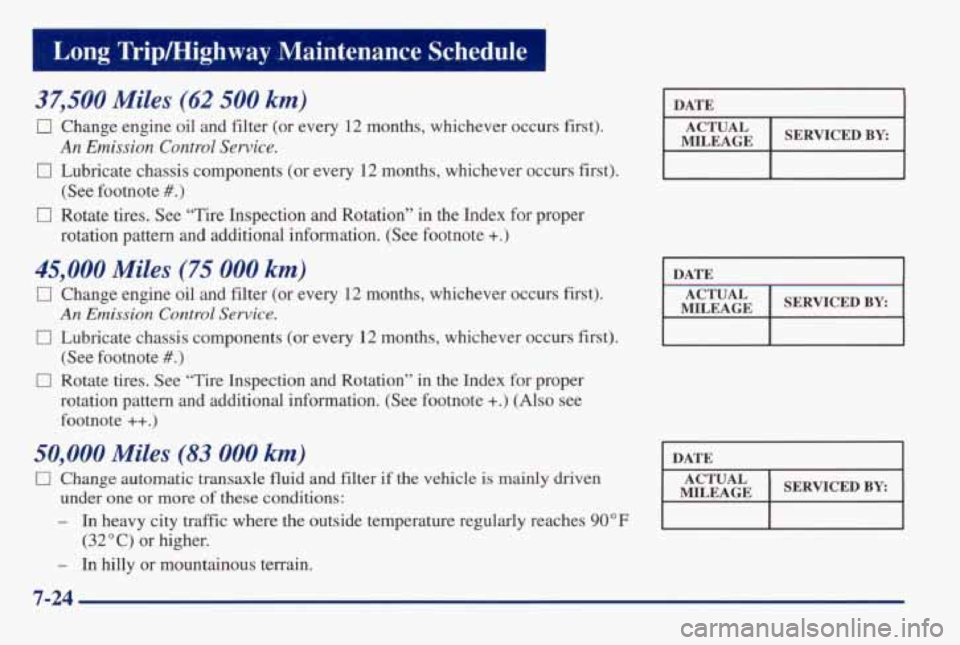
37,500 Miles (62 500 km)
0 Change engine oil and filter (or every 12 months, whichever o\
ccurs first).
An Emission Control Service.
0 Lubricate chassis components (or every 12 months, whichever occurs first).
0 Rotate tires. See “Tire Inspection and Rotation” in the Index for proper
(See footnote
#.)
rotation pattern and additional information. (See footnote +.)
45,000 Miles (75 000 km)
0 Change engine oil and filter (or every 12 months, whichever o\
ccurs
fist).
An Emission Control Service.
0 Lubricate chassis components (or every 12 months, whichever occurs first).
(See footnote
#.)
0 Rotate tires. See “Tire Inspection and Rotation” in the Index for proper
rotation pattern and additional information. (See footnote
+.) (Also see
footnote
++.)
50,000 Miles (83 000 km)
0 Change automatic transaxle fluid and filter if the vehicle is mainly driven
under one
or more of these conditions:
- In heavy city traffic where the outside temperature regularly reaches 90°F
- In hilly or mountainous terrain.
(32°C)
or higher.
DATE I
MILEAGE
ACTUAL SERVICED BY:
I DATE I
MILEAGE
ACTUAL SERVICED BY:
I DATE I
MILEAGE ACTUAL I SERVICEDBY:
Page 361 of 370

Easy Entry Seat ................................ 1-6
Electrical Equipment. Adding
...... 2.17. 2. 18.3.23. 6.59
Electrical System
............................... 6-59
Engine
.................................. 6.11. 6.12
Coolant ..................................... 6-25
Coolant Heater
............................... 2- 19
Coolant Level Check
.......................... 7-30
Coolant Temperature Gage
..................... 2-61
Exhaust
................. 2-1 1.2.31.2.32.4.29. 4.38
Fuse Block
.................................. 6-63
Identification
................................ 6-58
OilLevelCheck
.............................. 7-30
Overheating ................................. 5- 14
Running While Parked
......................... 2-32
Specifications
................................ 6-65
StartingYou ................................ 2-16
Engine Exhaust ............ 2.11.2.31.2.32.4.29. 4.38
EngineOil
.................................... 6-13
Adding
..................................... 6-15
Additives
................................... 6-18
Checking
................................... 6-14
Used
....................................... 6-18
WhatToUse
................................. 6-16
Whentochange
.............................. 6-18
Enhanced Traction System
......................... 4-9
Enhanced Traction System Active Light ......... 2.61. 4.9
Enhanced Traction System Warning Light
....... 2.61. 4.9
Active Light
............................. 2.60. 4.9
Warning Light
........................... 2.60. 4.9
Exhaust. Engine
............ 2-1 1.2.31.2.32.4.29. 4.38
Exterior Lamps
................................. 2-42 Fabric
Cleaning
............................... 6-51
Fifth Gear.
Manual Transaxle ..................... 2-25
Filling a
Portable Fuel Container .................... 6-5
FillingYourTank ................................ 6-5
Filter. Air ..................................... 6-19
FinishC are .................................... 6-55
FinishDamage
................................. 6-56
First Gear. Automatic Transaxle ................... 2-24
First Gear. Manual Transaxle
...................... 2-25
Flashers. Hazard Warning
......................... 5-2
Flat Tire. Changing
............................. 5-23
Fluids and Lubricants
............................ 7-36
FOgLmps
.................................... 2-44
Following Distance when Towing a Trailer
........... 4-39
Foreign Countries, Fuel
........................... 6-5
Fourth Gear. Manual Transaxle .................... 2-25
French Language Manual
11
Front Map Lamps ............................... 2-45
FrontTowing
.................................. 5-10
Fuel
.......................................... 6-3
Filling a Portable Container
...................... 6-5
Filling Your Tank .............................. 6-5
In Foreign Countries ......................... 6-5
.. ...........................
Gage ....................................... 2-67
Fuses and Circuit Breakers
........ .......... 6-60
Gages Engine Coolant Temperature
.................... 2-61
Fuel ....................................... 2-67
GarmentHook ................................. 2-51
GAWR
....................................... 4-33
9-4